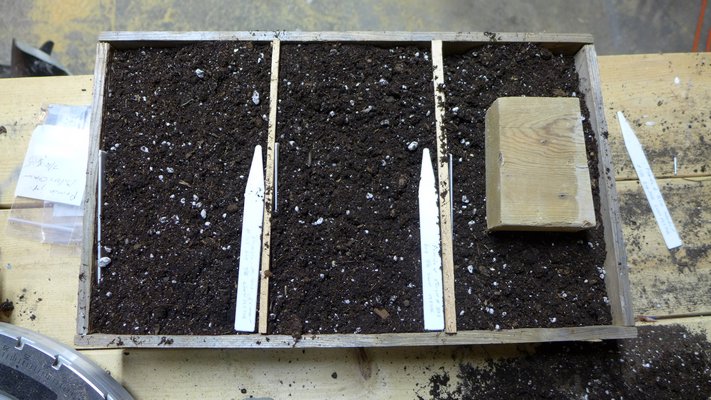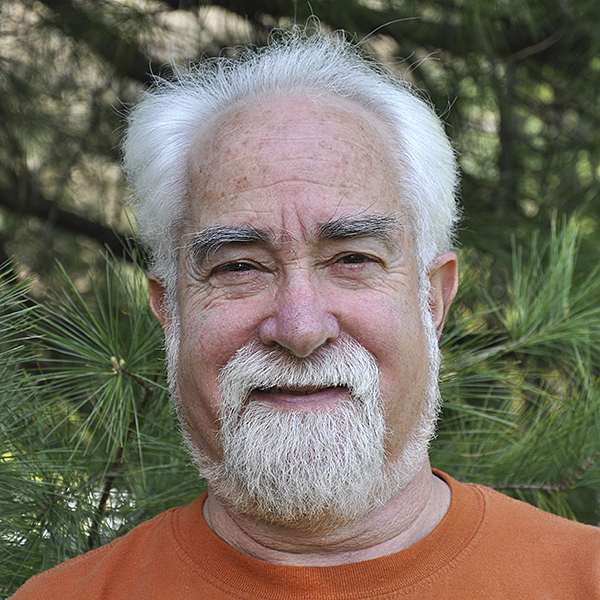

This week, the second part of working with seeds of plants that need cold treatment to germinate. It’s a challenge for sure, but there are some seeds that need alternating periods of freezing and thawing to initiate the chemical process of breaking down the seed coat and thus starting the germination process. Some seeds will complete the entire process in one winter-and-spring cycle. Others are more complex.When I was a member of the Royal Horticultural Society, one of the big benefits was their annual seed distribution. They’d send out a list of seed that was available, and you’d send in your choices, never knowing what you’d get, because it was first-come, first-served. One year, I was lucky enough to get some seed of a rare species of peony; very little was known about the exact germination regime, other than it needed cold treatment.
I had little experience with this—actually, none at all—so I put the seed into a pot, tagged it and put it into a cold frame. There it sat, and I completely forgot about it. That was until three years later, when, while cleaning out the cold frame in May, I was delighted to find that not only had the seed germinated but that I had a 3-inch-tall seedling of a somewhat rare peony! My grin was broad, to say the least.
Know if your seed needs to be covered or not, and, as mentioned last week, Norman Deno’s seed books or a seed catalog may help out here. This year, I’ve sown three varieties of Primula, Crocosmia, Trollius and the Callirohe. They all need vernalization, but each has its idiosyncrasy. (Again, rely on Deno.)
Use a good seeding mix with no soil from the garden. These mixes will contain some type of peat, possibly with sand and or perlite added, but it should not contain any fertilizer. For the past few years I’ve been using Espoma’s Organic Seed Starting Potting Soil with good results.
Moisten or dampen the mix in a pail or bucket (that’s moisten—not dripping wet) with warm water before filling the flat with at least 2 inches of the medium, and don’t pack it down. When filling the flat, use a small piece of wood to level the soil so there are no pockets or valleys, just a coarse but level seedbed.
Sow the seed in both directions on top of the soil and, once the seed is down, have a small piece of wood about 3 inches square and smooth on one or both sides. Use this piece of wood as a tamper to gently firm the soil and slightly compress the seed so that it comes into contact with the soil—but be careful not to compact the soil … just firm it.
If you have several varieties of seed you are sowing in one box (divided, of course), you should sweep off the block with your hand to make sure no seed of the previous sowing sticks to the wood and accidentally gets transferred to the next section. The same practice should be done between seed boxes. It’s one thing when you mix up the labels but another when you accidentally transfer seed from one section or box to another and only find out years later, when the wrong plants blooms in the wrong place in the garden.
If the seed is a “dark” germinator, sprinkle a light layer of soil (seed mix) or clean sand on top of the seed. If the seed does need covering, an eighth of an inch is usually adequate. The soil can be additionally moistened with a spray bottle, making sure not to dislodge the seed by using just a gentle mist.
Label each box or box section twice, using a plastic plant label marked with a pencil so the label has as least the seed name and the date of sowing. One label can be laid on top of the soil, with the second slid between the side of the box and the soil. It will be hidden but will be a godsend when you lose the other label.
Now you need to make a “cover” for the box that will keep rodents and inquisitive birds out. This is best done with hardware screening (also called hardware cloth) with a ¼-inch mesh. It’s rather stiff but can be cut with a tin snip, then cut at the corners. Bend the cut edges over the sides and corners of the box so it fits snugly over the flat, with the screen going down the four sides about an inch. There should be no space where a mouse can squeeze in.
The box now needs to go outdoors, where it will get light (but not full sun) and cold. Under an eave is a great spot, because the eave or overhang of the house or building will protect the flat from heavy rain and potential washouts.
But if you protect if from rain, how will the medium stay moist? When the medium freezes, there’s not point in watering it, but when the temperatures are in the upper 30s or 40s, you can mist it and that will keep it moist. The other great thing you should do is pile snow over the box. Anytime there’s snow on the ground, shovel some up and cover the box with it. The snow will keep the box cold, and the snow melt will benefit the germination process.
In this endeavor, patience is certainly a virtue. Most seeds will germinate between late March and early June. Some, however, take longer, with the hardest taking two years (or more), but these are rare and, of course, the most fun and gratifying.
What will you get? Well, I really wanted to do a large planting of Trollius, but at $12 or more a plant that was going to be costly. Instead, I collected seed from the plants in my garden and stored them in the refrigerator until December. In December, I seeded them in a seeding box, covered the box with screen and left it under the porch overhang. During the winter, I covered it with snow as much as I could, and come spring I watched and watched, waited and waited. As it got warmer, I had to make sure I kept the soil moist but not dripping wet.
Then, sure enough, the germination began, and within weeks I had over 200 tiny Trollius plants. They will produce their first flowers in my perennial border later this year.
It’s a long-term project but one that you’ll learn from, and you’ll get lots of surprises. If you don’t have saved seed, you can spend some winter time building your boxes and perusing Deno’s book, spend the summer collecting seed, and do your sowing next winter … and keep growing!
 More Posts from Andrew Messinger
More Posts from Andrew Messinger